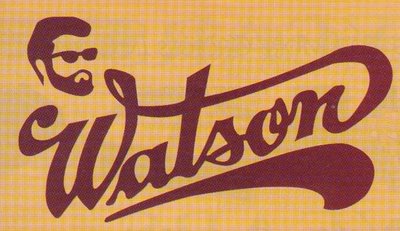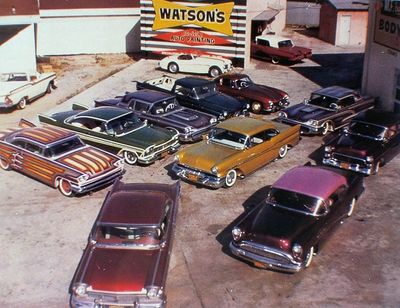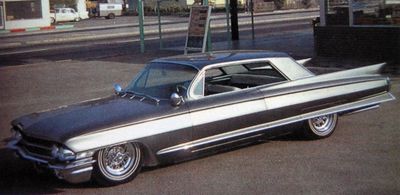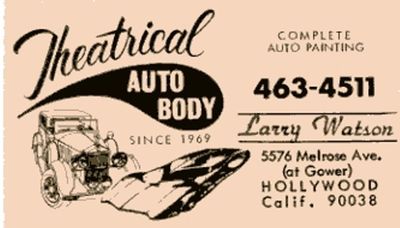Larry Watson

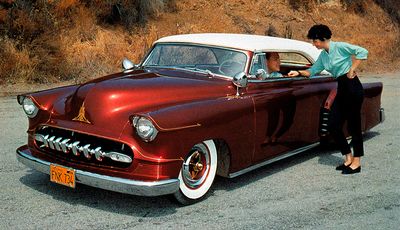



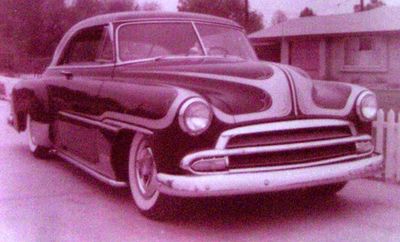











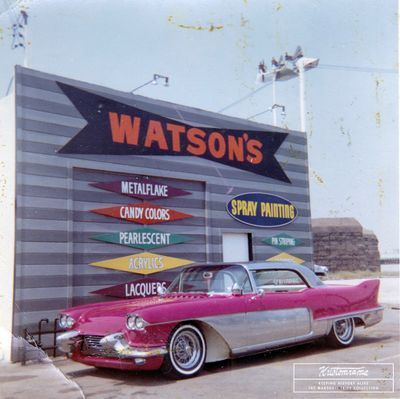

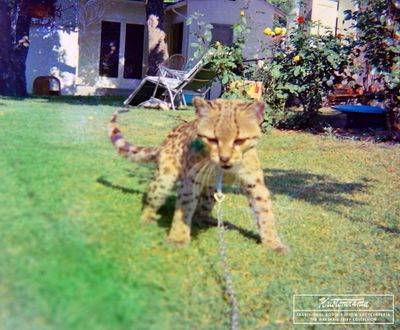












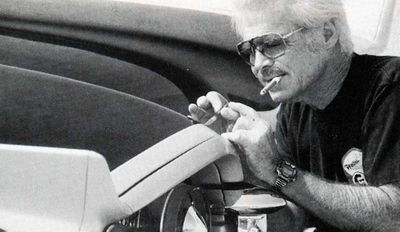




Larry Watson (July 21, 1938 - July 20, 2010) was a legendary custom painter and pinstriper.
In 1955, at the age of 16, Larry began his pinstriping career. His inspiration came from watching Von Dutch striping, while sitting on his bicycle outside of Barris Kustoms in Lynwood. One day his friend Gary McNaught came by the house and asked if he would come along down to Barris Kustoms and watch Von Dutch stripe a car. Von Dutch had moved his operation uptown working out of "The Crazy Arab's" Competition Body Shop at 7201 West Beverly Boulevard in Los Angeles, so instead it was Dean Jeffries doing his first striping for George Barris. The car he pinstriped was Johnny Zupan's 1949 Mercury. Larry stepped over the rope at Barris and asked Jeff where he had bought his brushes. Jeff answered "What do you want to do? Put me out of business?" At the time it was only Von Dutch and Dean Jeffries who applied what they called "Modern Striping." Larry answered that he just wanted to stripe his own car, but Jeff still wouldn't tell him. Larry went to an art store and bought some brushes, and he went to Jackson Paint Store and bought some copper paint. He spent the next two days striping his 1950 Chevrolet, the Grapevine. Once completed he drove his newly pinstriped Chevy over to the Bellflower Clock Drive-In where everybody wanted to know how the hell he could afford a Von Dutch artwork on his car. He told them he had done it himself. Nobody believed him, they even thought he had had Von Dutch sign Larry's name on the striping. Harvey Budoff called the bluff and pulled into Larry's driveway with his car one day after school. Larry finally found out where Von Dutch bought his brushes and paint. It was in a little store down on Compton Boulevard, west of Long Beach Boulevard in Compton. Harvey Budoff's 1950 Ford was the first car Larry pinstriped for a customer. After visiting the store he bought some German brushes and white 1-shot. He spent the whole day pinstriping the car. He put an eyeball on a spoon with blood dripping out of the spoon in the back of the glove box. Larry didn't tell Harvey about the artwork, but his girlfriend eventually found it. After that Larry was the hit of the drive-ins, and every time he got home from school there would be three or four cars sitting in the driveway ready to be striped. Among the most notable cars being pinstriped in Larry's driveway is Duane Steck's 1954 Chevrolet - The Moonglow.[2]
Contents
- 1 Keith Christensen Remembers Watson and his Little Chevy
- 2 First Flame Paint Job
- 3 First Shop
- 4 Larry Becomes Legal
- 5 Customizing With Paint
- 6 Running the Paint Department at Barris Kustoms
- 7 Pinstriping. "Watson was the Best"
- 8 First Metalflake Paint Job
- 9 The Bellflower shop
- 10 Moving to Mexico
- 11 While the Cat's Away
- 12 The Comeback
- 13 The Vegas Show Girls
- 14 House in the Hills
- 15 First Lace Paint Job
- 16 Watson Goes to Hollywood
- 17 New Shop. New clientele. The same labor-intense perfect paint jobs
- 18 David Mirsky Remembers Watson
- 19 The Spray Booth
- 20 Private Museum in Apple Valley
- 21 Larry Watson's Personal Rides
- 22 Cars Painted and Pinstriped by Larry Watson in his Parents Driveway
- 23 Cars Painted and Pinstriped by Larry Watson at Watson's House of Style
- 24 References
- 25 Sources
Keith Christensen Remembers Watson and his Little Chevy
Keith Christensen first met Larry in 1955 when he visited a Coachmen car club meeting. "He was introduced that evening to the club members. When we took our break, the gang went outside to look at the pinstriping work he had done on his own car - a little 1950 Chevrolet," Keith told Sondre Kvipt of Kustomrama in 2020. "It was Chocolate brown on a tan car and the quality of work was outstanding. This was previous to him starting up his painting vocation."[3]
First Flame Paint Job
Larry applied his first flame paint job on Buzzy's Ford. Von Dutch was doing crab-claw-style flames, so that's what Larry also did. Walking back and forth to get the flames symmetrical, the paint job took 6 hours. After Buzzy cruised the Clock with his newly painted Ford, other people also wanted Larry to lay flames on their cars. After painting a brand new 1956 Oldsmobile he laid in bed thinking about what he could do in order to make the job go faster, he was tired of the 6 hours work it took. Laying in his bed he hit upon the idea of using with tissue paper and a bright red china marker. That was it, after that it took only 2 hours. In 1956 Larry shot his first metallic paint job and his first scallop job. The first car he scalloped was Bob Schremp's 1954 Chevrolet. Bob had Branson Auto Body in Artesia paint his car. During the job they put a run underneath the trunk and one on the hood, so he turned to Larry and asked if he could cover the runs up.[2]
First Shop
Upon graduating from school in September of 1957, Larry opened his first paint shop. Keith Christensen remembers him in his youth, without a beard or styled hair, moving into a building directly across the shop area from his original Gene's Mufflers shop in Paramount. "There he took on his aura of beard and styled hair," Keith told Sondre Kvipt of Kustomrama in 2020. Keith recalled Watson first opening up a little shop close to Nance Chevrolet company on Bellflower Blvd in Bellflower. "He started painting cars,"Keith recalled. "He would wet down the floor of an old garage for the sake of dust, and painted inside. It wasn't long before the fire department came and close him down." In May of 2020 Roger O'Dell told Sondre that the exact location of Larry's first shop was on Palm Street, where the 91 freeway westbound off-ramp for Bellfower Blvd is today. "The shop area is buried under the off ramp." Roger recalled Nance Chevrolet being located at 17046 Bellflower Blvd., on the corner of Bellflower and Park Street. Later on, Clutch & Gear was located in the Nance Chevrolet spot on Park Street. Bob Williams and Jerry opened up Clutch & Gear after leaving Stu's Transmission in Long Beach. In 2020 it was a bank on Bellflower Blvd., and on Park Street, the area where Clutch & Gear was. "Palm Street, south of Park Street, east of Bellflower Blvd. the part that used to run into Bellflower Blvd. is now a freeway off-ramp, and Palm is a dead end."[4]
Larry Becomes Legal
Keith remembers Watson then moving over on to Park street in another small garage where he went through the same scenario. "From there he moved in next to my shop on Lakewood Blvd, in Paramount, across the street from the border of Bellflower. He had a group of back yarder's come in and install an old paint booth he had found and bought." Watson was finally legal, and Keith remembers him advancing from a few custom paint jobs to Candy paint and onto gorgeous pearls.[3]
Customizing With Paint
Larry decided that he wanted to start a new trend: customizing with paint. In order to promote his new trend, Larry bought a brand new 1958 Ford Thunderbird that he took to Barris Kustoms for some mild modifications. Bill Hines and Bill DeCarr that worked at Barris Kustoms nosed and decked the car, shaved the handles and rounded the corners. After that Larry painted the car with six coats of pearl over a fine metallic silver base. Larry didn't tint the pearl with transparent mixing black toner that eliminated the cloudiness and he thought the car turned out too bright. Larry thought the bright look made the car look way too large, so in order to fix it up, Larry taped the panel lines of the bird with 1-3/4 inch tape and shot candy apple burgundy over it.[5] With this paint job many think that Larry invented the Panel Paint Job. The Thunderbird was the first car featuring a silver pearl and candy burgundy paint job, but before he painted panels on his own car he had already paneled Zeno Stephens' 1955 Mercury. Zeno wanted something different, no scallops or flames, so Larry body paneled it. Larry painted the car in Tahitian Red and striped it in gold. After painting the car Larry never saw it again, not in a magazine, or at a car show, nowhere.[2]
Running the Paint Department at Barris Kustoms
One day George Barris called Larry and asked if he could do some paneling on the Rod & Custom Dream Truck. Barris was just starting to paint candies, and he'd shot candy lime over silver. There were a few mistakes, so he called Larry and asked if he could cover them up with scallops in Candy Burgundy over silver metallic. In 1958, not long after painting the Rod & Custom Dream Truck George called Larry again, and asked if he could take over the paint department while he, Dean Jeffries and Bill Carr were going back east on a 2 month tour. When George called they were building a pizza parlor in front of Larry's shop, so he said ok. When Dean Jeffries returned from his trip back east, Dean and Larry were kicking ass together, knocking out three or four scallop and flame jobs a day, and pinstriping their asses off in between. After about 4 months he relocated back to his own shop in Bellflower.[2]
Pinstriping. "Watson was the Best"
According to Teddy Zgrzemski, who worked as a painter's helper at Barris Kustoms, Watson was probably one of the best pinstripers he ever saw back in the old days. "He could pinstripe a straight line, and it was unbelievable," he told Sondre Kvipt of Kustomrama in 2021. "The 58 Thunderbird that he had. He striped that thing in a golden tan, and then a couple of days later, he didn't like that, so he went over the whole thing with a lavender color. Right over on top of that other pinstriping, and you could never see what the original color was. He was very good at pinstriping long straight lines. Jeffries was good too, but I think Watson was better at the long lines."[6]
First Metalflake Paint Job
In 1960 Larry applied his first Metalflake job on Ron Aguirre's Corvette, the X-Sonic. The X-Sonic also featured Watson's first fade paint job. As Aguirre kept modifying the car, Watson painted it six times. As Larry matured, he became the great painter that everyone would recognize. "In the early 1960s he started innovating painting. From flames, to blending of colors, to two tones of the very expensive Murano pearl, which at that time was made up of abalone seashells blended into the paint. It was astonishing what he developed and did," Keith Christensen recalled in 2020.[3]
The Bellflower shop
After a while, Watson moved into a shop in Bellflower, at Lakewood and Artesia street. From there he moved onto a shop in Downey and went into partnership with Pete Angress. He sold his half to Pete, and at a later date moved to Hollywood. Keith Christensen believed the Hollywood shop was on Santa Monica Blvd., a few blocks from Paramount Studios. "I visited it several times. In fact, his hangout was the Whiskey a Go Go. A bar that was a hang out of many famous people. Even though Larry never drank." Keith went with him several times. "It was the thing to do in Hollywood. There he thrived by trading out work to the stars by painting their cars. Lucille Ball's Rolls-Royce, Sammy Davis Jr.'s Jaguar XKE, Mike Connor's Rolls-Royse and many others."[3]
Moving to Mexico
Between 1960 and 1966 Larry got tired of all the masking and striping, and he started doing mostly straight candies with Metalflake or Pearl tops, or Pearl bottoms with matching Candy tops.[5] Larry was kicking ass working from 12 to 20 hours a day, 7 days a week. He had 5 or 6 helpers.[2] At the peak in 1966, Larry sold the shop he had on Lakeward Boulevard in Paramount, and moved to Mexico in order to pursue an acting career with his wife.
While the Cat's Away
When Watson moved to Mexico he left behind a big gap in the market, and while he was away, two other "Watson" custom paint shops sprung up in the area offering custom paint jobs to teenagers that didn't know better. One of the shops, Watson's Custom Kars was located in Downey. The other one, Watson's was located in Van Nuys on Burbank Blvd.
The Comeback
Late in 1966 Larry returned to California to open up a new shop in Bellflower. The new shop was located on 17412 Lakewood Blvd., on the corner of Artesia. Back in business, Watson made flyers that contained an important notice about the imposters that had been using his name while he was away; "Larry Watson is not associated with Watson's Custom Kars in Downey and the Watson's in Van Nuys on Burbank Blvd. - And - Disclaims all responsibility of work coming from those locations. To whom it may concern! It's only a Watson Paint Job when Larry Watson does the painting personally." Marshall Tripp worked for Larry between 1966 and 1967. At the time Ken McGoldbrick was the manager in the shop. In 2016 Marshall told Kustomrama that "Kenny was the "manager," although Larry was always there. He was a good guy and knew his stuff when it came to Larry's work. He taught me how things should be done." Marshall remembers that Joe Perez did Watson's interiors while he worked for him; "I remember Watson saying once "you'll never win best interior with black.""[7]
The Vegas Show Girls
Marshall Tripp remembers that Larry once took a few days off and went to Las Vegas; "A week later, he was out to lunch and these four Vegas showgirls show up to see him. As a young fellow, I was very pleased to host them until he returned."[7]
House in the Hills
When Marshall Tripp worked for Larry, Watson had a house near the shop. Around 1966 - 1967 he bought a house in the Hollywood Hills. Marshall once drove him to the house to check progress on the remodel work. Brian Epstein of the Beatles lived two houses to the west or north.[7] Keith Christensen recalled Larry remodeling several houses in the hills, selling them for a good profit.[3]
First Lace Paint Job
After Larry had opened up the shop in Bellflower, he determined that he had to get his name back on the show circuit, so he decided to do something completely new for the upcoming show at the Los Angeles Sports Arena in April 1967. Larry was painting Doug Carney's 1963 Pontiac Grand Prix for the show, and decided to do a lace paint job on the car. Ha had never tried the technique before, but Von Dutch had told him about a doily that ha had on a bench in his shop. One day while cleaning up in the shop he had removed the doily, and a beautiful overspray pattern had been left on the bench. Von Dutch dug the design and painted clear all over it. While wondering about what to do with Doug's Pontiac, Larry remembered this story and decided to paint the whole side of the car using a lace pattern with Lucky Lager Double X Pattern. Many believe that custom painter Joe Andersen invented the technique as he demonstrated it in the Rod & Custom March 1968 issue, one year after Larry painted Doug's Pontiac.[5] Larry's newly painted Pontiac made its debut at the April 1967 show together with 53 other cars in the center arena of the car show, which was sponsored by the Tridents Car Club. At the same show, he also had over two dozen motorcycles upstairs.[2]
"Lacing the sides of a car was marvelous," Keith Christensen recalled, "as seen on Doug Carney's 1963 Pontiac. I helped Larry with a couple of lacing jobs. We would set up saw horses on either side of the car and have to position them perfectly - just inches away from the side of the car - tedious and critical. Then we would take an expensive lace table cloth and stretch it between the sawhorses - even more critical a distance. This is all after the car had just been painted some wild Candy or Pearl." The finesse of the next step was the crucial step, Keith remembered; "Larry had only one pass along the side of the car to fog through the lace. He would take a beautiful paint color and turn the pressure of the paint gun up and walk the full length of the car in one long smooth, balanced sweep. A real test of talent as Larry would not have a second chance, as the paint would fog through the lace tablecloth and onto the side of the car and had to land perfectly and equally - No second chance. If it was not perfect, the whole side of the car had to have the lacing fog taken off." According to Keith, "Larry's intricate preparation and his talent came out in all this. The paint jobs were the talk of the town and won awards at a lot of car shows."[3]
Watson Goes to Hollywood
After the 1967 Tridents Rod Custom Autorama Watson he figured that he couldn't get any further, so he decided to sell his shop and get out of the business.[2] He left the custom car scene in favor of a blossoming TV and movie acting career. Larry joined the Theater Actors Guild and started getting small non-speaking parts in many movies. Keith Christensen recalled that while he was still next to his shop in Paramount, he got a small part in Ben Hur, and when he came back to his ship, he and one of his workers were wearing regalia from the movie. "This I feel, fueled and motivated him to go further with acting. He associated himself with Norm Grabowski." Keith believed Larry learned the rope from him. "His big break came when he was introduced to Mike Conners of the TV series "Mannix." Mike's family liked Larry and he started getting a lot of bit parts and finally a one-line speaking part. Larry used to show me some of his residual checks from the Actors Guild and he was proud of the passive income they represented."[3]
New Shop. New clientele. The same labor-intense perfect paint jobs
Larry painted and striped numerous luxury or sports cars for actors, actresses, directors, producers, or casting directors to gain entree. Keith Christensen would periodically visit Larry at his Hollywood shop. "It was quite a different atmosphere," Keith told Kustomrama in November of 2020. "Different divergent customers of all nationalities, ages, and wealth." Larry had the typical hang arounds and workers, and Keith recalled that it was a big challenge for him to find any help in prepping a car, "which I have mentioned before, is 70% of the quality of a paint job." Larry initially painted thru contacts he had made while getting non-speaking parts in movies. "He developed many friends and customers, and one of his biggest friends and contact was Mike Conners. He befriended Larry and gave him many small, non-speaking roles in many episodes in that long-running series." Mike sent Watson a lot of paintwork on fellow actors' cars. "Larry painted Lucille Ball's Rolls Royce a beautiful pearl pink. He also painted Sammy Davis's Jaguar XKE a beautiful Murano pearl yellow. I saw both cars in process on one of my many visits to the Hollywood shop. They were perfect, pristine, and really stood out. Larry's demand for quality showed in both of them. Again I say, he had a hard time finding anyone to sand and mask a car, as it was labor-intense and had to be done perfect! When preparing a car to be painted, in the majority of the time, chrome strips had to be removed, bumpers taken off as well as rearview mirrors and headlight rings. Very tedious! Any masking paper that was, by accident put on to the paint area, rather than where it was covering, would leave the other, original color of the car showing. Larry was a tyrant of sorts and a great teacher to all of his workers. He did, however, produce some of the most beautiful paint jobs of that era. The cars were sanded 3 times during the paint job. This would remove any blemishes, any scratches, and of course, orange peel, which is like an orange with many little valleys."[3]
Keith watched Larry lay down several paint jobs, and he recalled that when it started, the base, the reflective color was put on by Larry, "then the car would leave the paint booth and outside it would be color sanded with a very fine-grit sandpaper. Then back into the booth for many rounds of spraying on the finished color. Quite often with a candy color, the base coat had to show thru. The number of times Larry walked around the car applying coat after coat," and this is where Larry shined, according to Keith; "He could tell, in the painting rounds, just how far to go. Then, out of the booth again, and again, the car was color sanded for hours at a time to make this final coat like a mirror. Once more after making sure non of the tape had come off, the car went back into the booth. Larry, would then, put the protective coat of clear paint over the top of the gorgeous color. Many rounds he would walk around the car applying the clear. As a finale, this new clear coat was color sanded to the highest of smooth finishes. All of this was very hard work and a lot of talent. I can personally remember Larry at his Paramount, California shop, taking a car out of the paint booth and having his workers completely strip off the paint he just applied, as it didn't satisfy what he felt it should look like. WOW, a person speaks of labor intense, this was the epitome of it..."[3]
David Mirsky Remembers Watson
In the early 1970s, David Mirsky was a neighborhood kid that worked for Larry part-time at his shop on Santa Monica Blvd in West Hollywood, and at his Melrose Avenue shop in Hollywood. David was one of those kids that hung around Larry's shop, that after a while was put to work. He was around 15 or 16 years old at the time, and Larry used him to take parts of cars, prep them for work and paint, color sanding and all sorts of other tasks. He was paid in hamburgers and fun, and he recalls working on Evel Knievel's jet bike, something that was really cool for a 15 years old kid. To David and his friends, Larry was the coolest guy they had ever met. He was a magician with cars and a good looking guy always looking for acting gigs. To David, Larry was who Burt Reynolds copied himself after. David remembers that Larry always had a slim cigar in his hands. He used the cigar as a prop when he made his points. David worked for Larry for a short period of time, and he remembers him as a good guy that always treated him as a friend. Larry painted a Bell Star helmet for David in 1971 that he still owned in 2013.[8]
The Spray Booth
Keith Christensen remembers he and Larry lining up a time to meet at Larry's Hollywood shop in the 1970s. "He would take me over to the movie studio's gate and lot and get me in the vault of a front gate by telling the guards that I was an extra. Once inside, walking the streets there, we would pass many people dressed in costume for certain movies that were being filmed. Larry took me inside one of the studio buildings, and we sat down in some mini- bleachers and watched the making of a film. One in particular, because it was of our era, was "Happy Days" with the "Fonzie." My gosh, the set and clothing were right out of the fifties." Keith and Larry had to stay totally quiet and watch makes and remakes for hours, "just for one or two scenes. Quite an adventure for a custom car shop owner like myself."[3]
Larry's acting career led him on a great path and even a house in the Hollywood hills. Keith recalls that he also gained various fantastic friends who helped him on his quest to be a movie star. "He showed me a story script of a movie he was writing, all about the 1950s. He had the assurance that it would be successful as at that time movies were out like "Fast times at Ridgemont High and of course, Grease." Keith doesn't know anything about the outcome of Larry's endeavor, writing the movie, but he believes he was on target with its content. We know that Watson visited car shows in the late 1970s, handing out flyers on cars that he wanted to use in the movie. The movie was named "The Spray Booth," and Watson looked for racers, hot rods, customs, and stocks 1956 or older. There were several similar visits for Keith, and Larry even took him night clubbing at the legendary Whisky a Go-Go. "Neither he nor I drank, so I got a sober look at the nightlife in Hollywood! Oh my gosh, I realized what a different world his part of the world was!!"[3]
The backside of the flyer for Watson's movie project shows a print of Larry's business card. On that card, he promotes his business as "Watson's Custom Auto Painting", Since 1955. His shop was located at 5576 Melrose in Hollywood. On a later business card, he had changed the name to "Theatrical Auto Body", Complete Auto Painting Since 1969. The shop was still located at 5576 Melrose Avenue in Hollywood.[9]
Private Museum in Apple Valley
Between 1967 and 1985 Larry ended up in 141 different shows, such as MacGyver, Columbo, and Mission Impossible.[10] Watson eventually left the Hollywood hills, moving into an area in Riverside County called Hemet. He painted a few cars there, but according to Keith Christensen he was not happy with the area, so he moved to Hesperia in the high desert and retired. Larry retired in Apple Valley, California, and spent much time creating his private museum loaded with pictures and artifacts from his custom car and TV days. In 2008 Watson and Gene Winfield started hosting a hot rod and custom car show at Gene Winfield's shop in the Mojave desert. The first show, called Gene Winfield and Larry Watson Custom Car and Hot Rod Gathering, was held on October 19, 2008.
Larry Watson passed away at the age of 70 on July 20, 2010. After his passing, the museum was awarded to his son. Originally, Larry met and married a Hollywood startlet by the name of Camille Chebo. They had one child. When they divorced, she took the boy and moved to Mexico. The son closed the museum up, and in 2020 it was still there getting all dusty but preserved.[3]
Larry Watson's Personal Rides
Larry Watson's 1950 Chevrolet - Grapevine
Larry Watson's 1957 Cadillac Eldorado Brougham
Larry Watson's 1958 Ford Thunderbird - Vino Pasiano / The Burgundy Bird
Larry Watson's 1959 Cadillac 62 Series Coupe
Larry Watson's 1962 Cadillac
Cars Painted and Pinstriped by Larry Watson in his Parents Driveway
Larry Watson's 1950 Chevrolet
Santo Vasques' 1950 Chevrolet Convertible
Buzzy's 1950 Ford
Jake Bultsma's 1951 Chevrolet Bel Air
Hayward Mendenhall's 1953 Ford F100
Bob Schremp's 1954 Chevrolet Bel-Air
Duane Steck's 1954 Chevrolet - The Moonglow
Danny Purinton's 1956 Mercury
Cars Painted and Pinstriped by Larry Watson at Watson's House of Style
Click here to see cars painted or pinstriped by Watson's House of Style
References
- ↑ Rik Hoving Custom Car Photo Archive
- ↑ 2.0 2.1 2.2 2.3 2.4 2.5 2.6 Barris Kustom Techniques of the 50's Volume 4
- ↑ 3.00 3.01 3.02 3.03 3.04 3.05 3.06 3.07 3.08 3.09 3.10 3.11 Keith Christensen
- ↑ Roger O'Dell
- ↑ 5.0 5.1 5.2 The American Custom Car
- ↑ Teddy Zgrzemski
- ↑ 7.0 7.1 7.2 Marshall Tripp
- ↑ David Mirsky
- ↑ The HAMB - Went to Larry Watson's house yesterday
- ↑ www.imdb.com
Sources
Did you enjoy this article?
Kustomrama is an encyclopedia dedicated to preserve, share and protect traditional hot rod and custom car history from all over the world.
- Help us keep history alive. For as little as 2.99 USD a month you can become a monthly supporter. Click here to learn more.
- Subscribe to our free newsletter and receive regular updates and stories from Kustomrama.
- Do you know someone who would enjoy this article? Click here to forward it.
Can you help us make this article better?
Please get in touch with us at mail@kustomrama.com if you have additional information or photos to share about Larry Watson.
This article was made possible by:
SunTec Auto Glass - Auto Glass Services on Vintage and Classic Cars
Finding a replacement windshield, back or side glass can be a difficult task when restoring your vintage or custom classic car. It doesn't have to be though now with auto glass specialist companies like www.suntecautoglass.com. They can source OEM or OEM-equivalent glass for older makes/models; which will ensure a proper fit every time. Check them out for more details!
Do you want to see your company here? Click here for more info about how you can advertise your business on Kustomrama.

